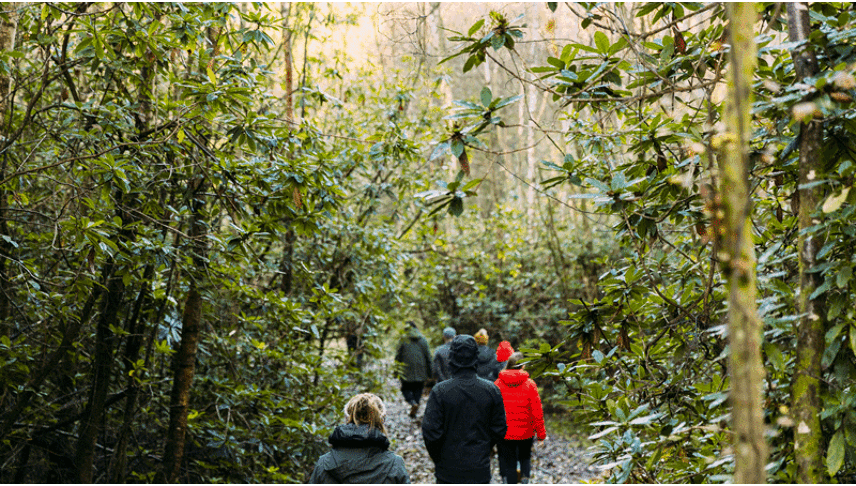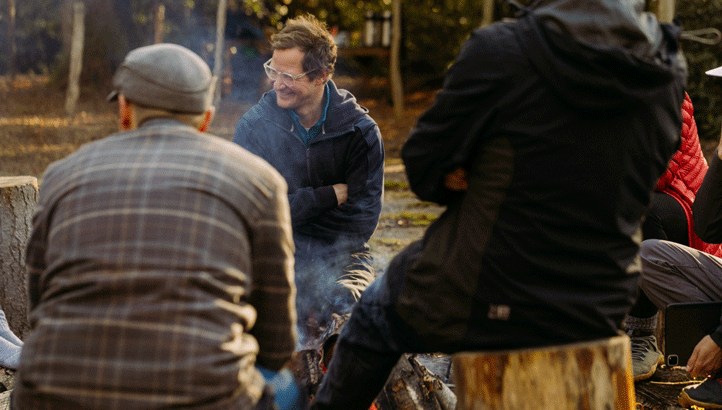Register for free and continue reading
Join our growing army of changemakers and get unlimited access to our premium content

Image: Giles Hutchins. Pictured: Professionals taking part in a 'regenerative leadership immersion' session
Recognising that companies can often move faster than countries on climate, and accounting for the ways in which the climate crisis intersects with the nature crisis and with widening social inequalities, a growing cohort of visionary businesses are pledging to have a net-positive impact on people and planet.
The term ‘net-positive’ itself is not new. But the movement has certainly been growing in recent years, particularly due to the increased questioning of the purpose of businesses during the Covid-19 pandemic and other global challenges of the 2020s.
2021 saw former Unilever chief Paul Polman teaming up with Andrew Winston to publish a book on the matter, and Harvard Business Review publishing a net-positive manifesto. The net-positive movement has been gaining big-name business advocates in recent years, including Ikea, BT, Target and Levi Strauss.
As with many sustainability movements, net-positive visions had been pioneered by smaller organisations for years before these corporate giants really began to move.
But can a business of any size contribute to the regeneration of climate, nature and society without first transforming its internal cultures, structures and leadership styles?
Vivobarefoot’s founder Galahad Clark believes that the answer is likely ‘no’. He confesses to edie that he found that “in many ways, the company’s layout and its vision were at odds with each other for several years” after it was founded in 2012, aiming to be one of these smaller and bolder entities on net-positivity.
Vivo had stated a mission to bring people closer to nature from the outset, partly by literally selling them footwear which promotes grounding and is suitable for outdoor activities, made with a low environmental impact. But, as the global footwear market is highly fragmented and competitive, Vivo grappled to sell enough pairs. The team also did not necessarily set aside the time and headspace for the non-urgent but crucially important task of embedding its purpose beyond its products.
“In the very early days of the business, we were, arguably, in survival mode… learning business 101, as it were,” Clark says. “Once we were out of the woods metaphorically, it felt overdue to come into the woods for real.”
Organisation as organism
The ‘real’ woods that Clark refers to are based at Springwood Farm in West Sussex. Clark and his team regularly attend the Farm for what are known as ‘leadership immersions’, hosted by strategist and coach Giles Hutchins.
Hutchins elaborates on Clark’s point, telling edie: “VivoBarefoot’s mission is about connecting nature with human nature. Having an internal culture, an environment that does not encourage that would be a nonsense.
“Mechanistically, we turn purpose into a mission statement or a chart… deeper purpose is about how people and organisations gain meaning from everyday interactions.”

Pictured: Galahad Clark at Springwood Farm
Hutchins is perhaps the UK’s longest-serving regenerative leadership coach, working with people from an impressive array of businesses including Unilever, Wilko, Sky, Capgemini and Toast Ale. Chief executives, board members and sustainability professionals from these and other organisations have worked with him.
edie asks Hutchins to summarise what it actually means to be a regenerative business leader. He says that such an individual is “essentially attuning with the way life works, allowing themselves to get back into accord with nature”.
Hutchins elaborates: “There is a rising zeitgeist around the term ‘regenerative’, which is everywhere at the moment.. In things like regenerative agriculture, regenerative medicine or regenerative economics, we look at how living systems work and apply that knowledge. For a business as a whole, and for leaders, it’s a bit different. A key piece is being able to recognise that an organisation is not a machine, or a top-down hierarchy – it is full of human relationships.
“It sounds quite obvious, but it’s surprising how often we do think of a business like a machine made up of charts, functions, siloes. That creates a certain narrowing of our awareness.
“Sometimes, when we critique capitalism, we fail to critique the mindset that sits underneath it. In trying to change capitalism with a mechanistic mindset, we don’t get very far…. A lot of the environmental movement, which I’ve been in for most of my life, is getting caught [here].”
For Hutchins, a key part of the “mechanistic mindset” – thinking of a business or even a person as a machine disconnected from nature – is the compulsion to divide things into categories and hierarchies. There are managers and their subordinates. There is the sustainability team and the finance team and the strategy division, separate from the innovation team. In contrast, a regenerative business will have less of a vertical structure.
Another key division made in the mechanistic mind is that between the internal workings of an organisation and its impact on the world externally. Hutchins says: “The inner nature of an organisation, as a living system, is its culture. The outer nature is the value proposition – not just the product, but also community participation. They are absolutely connected.”
After all, old business cultures and mindsets are what have enabled businesses to externalize the true negative impact of their value chains for decades.
Over the past few years, there have been more than a few examples of business’s stated external value propositions being found to be at odds with their stated or perceived culture and governance. Four in ten fashion retailers withheld payments from suppliers during the early stages of the Covid-19 pandemic, despite many stating commitments to better livelihoods for garment workers. Energy majors have been increasingly pushing adverts relating to their investments in low-carbon technologies, despite fossil fuels still accounting for more than 90% of their overall investment plans. The likes of P&O and British Airways have been hauled over the coals for mass firing and rehiring.
For Hutchins, a truly regenerative business is one that always “goes beyond the presentational”. Making a ‘race to the bottom’ is against the nature of a regenerative leader and their organisation, who would instead strive for radical transparency and “not cut back on things that genuinely enable them to be future-fit”.
On the radical transparency piece, Vivobarefoot recently published an interactive, digital map of its value chain.
Spending time, taking time
We know that the general public is calling out businesses that are greenwashing and racing to the bottom, with regulatory structures improving at a pace to give consumers ways to better hold businesses to account. At the same time, businesses with strong purpose tend to outperform their sector, with Unilever’s Sustainable Living Brands being an oft-cited case study.
We also know that investors are increasingly requesting environmental and social information from the businesses they invest in. Earlier this month, 746 investors collectively managing more than $136bn of assets wrote to some 15,000 companies urging better disclosure, via the CDP platform. Their call to action mentioned both that inaction builds up risks for the business and the whole system over time, and that bold action presents innovation opportunities.
Nonetheless, a business may still feel loathe to transform to align with nature. Living in line with nature, in a personal capacity, is often referred to as ‘slow living’. And can a business afford to be ‘slow’ in an increasingly fast-paced, increasingly digital economy? edie puts this challenge to Clark and to Hutchins.
Clark says: “Nature never rushes but gets everything accomplished. It’s time for us to embrace that.
“It is true that having a more networked organisation with less of a pyramid does make it arguably more complicated. But, I think, it’s worth it in the end. A lot more of our people are now closer to our customers, and, ultimately, we’re providing a better service to society.”
More broadly, beyond VivoBarefoot, Hutchins elaborates that a need to “drill down” and achieve record-breaking project after record-breaking project in rapid succession is a sign that a company is still in a mechanistic mindset full-time. But he emphasises the importance, in a regenerative mindset, of only being able to tap into mechanistic thinking when necessary, rather than becoming stuck there all the time and getting stuck in the churn.
He explains: “Leaders have to be able to embrace fast-moving change. Cultures have to become more self-managing, because hierarchies become very burdensome in this time, creating a real drag.
“The mechanistic mindset prides itself on efficiency and effectiveness, but our organisations today are woefully inefficient. And the biggest inefficiency is that we are managing others’ impressions of ourselves.”
For VivoBarefoot, the framework for regenerative thinking (which it calls ‘The Vivo Way’) links closely to its own advice on effectively wearing its shoes. It consists of upright posture (clear and robust governance), taking little steps (failing fast, remaining agile), relaxing and falling into a rhythm (embedding regenerative culture through day-to-day work) and taking on sensory feedback (assessing for present and future opportunities and challenges, quickly correcting course).
A key part of implementing the ‘upright posture’ was conducting what Clark describes as a “radical restructure” of roles and responsibilities within the company. “Although some hierarchy remains,” the company’s latest annual report states, “we’re consciously shifting our individual and organizational relationship with power and control, from a parent-child to an adult-adult coaching culture”. The report argues that this “invites” staff to “bring more of themselves to work”.
‘Bringing more of oneself to work’ refers not only to their ability to be honest, making for faster failure and course correction, but to chances to showcase and nurture different skills, Hutchins says.
“The mind has different capacities… which we close out when we get into mechanistic thinking. Insights. Opportunities to learn. Creativity. Chance meetings. Intuition.
“We’re not wasting time, we’re actually improving time by bringing in far more ways of knowing from our repertoire.”
Hutchins’ overarching conclusion is that businesses led in a regenerative manner are “not slower, just different”.
Clark adds that, although most can see the benefits of this way of working, humans are prone to “cling to what we are comfortable with”.
He says: “I am surprised every day… the most surprising thing is probably seeing people coming into the business from bigger organisations with more structure and more hierarchy in roles and needing to let go of this. A lot of people have spent their career feeling they are climbing up a ladder and they don’t want to be told to step down, even if it is to walk across the hall and start climbing a different ladder.”
“It’s certainly not easy. In many ways, it’s a more complicated path.”
Yet taking this path has clearly opened opportunities for VivoBarefoot to become a more entrepreneurial business. For example, it is in the final stages of preparing to launch bespoke shoes in 2024, created using 3D scanning and printing, under an innovation known as ‘Vivobiome’. It is also going beyond products by offering health assessments, courses and coaching known as ‘VivoHealth’.
If examples of innovative projects don’t make the case, financial success probably will. Vivo recorded a 36% year-on-year growth in revenue in 2022.


Please login or Register to leave a comment.